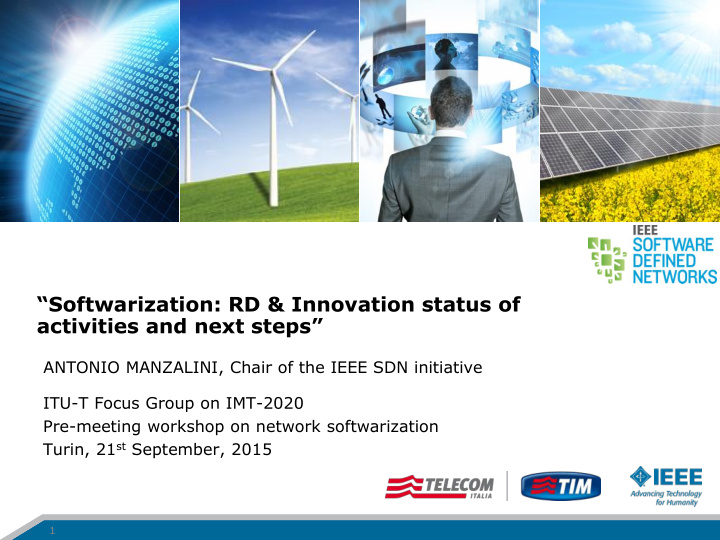



“Softwarization : RD & Innovation status of activities and next steps” ANTONIO MANZALINI, Chair of the IEEE SDN initiative ITU-T Focus Group on IMT-2020 Pre-meeting workshop on network softwarization Turin, 21 st September, 2015 1
Initiative Goal IEEE SDN is a cross-societies initiative aiming at developing a worldwide RD&I cooperation on Software Defined Network (SDN) and Network Function Virtualization (NFV) by creating the conditions for a pre-industrial impact in Telecommunications and ICT. A main challenge will be overcoming current “fragmentation” by reaching a critical mass of leading technical experts (both from Industry and Academia), business managers of LE and SME, Entrepreneurs, Open Source communities, early adopters, Regulators, Policy makers, real Users, etc; IEEE SDN core team is composed of about 50 Experts actively involved in7 Committees: Conference, Education, Publicity, Publication, Standards, Pre-Industrial and Out Reach; Initiative is currently followed by the a Technical Community of about 2500 people.
What’s today understanding ? The two basic principles of SDN – NFV are not new: • • the former is about the separation between s/w and h/w has been around for a long time (e.g., active and programmable networks); • the later leverages on virtualization of network and IT reseources which was demonstrated and exploited in IT systems after in the ‘ 60ties; What’s new is the techno-economic context, making SDN-NFV sustainable • At the beginning SDN – NFV have been mainy considered as technologies for the • evolution of current core Telecommunications networks (e.g., routers, switches, transmission nodes, and middle-boxes); IEEE SDN has argued that said paradigms are part of a broader systemic trend • called «softwarization» which will impact all Telecommunications and ICT areas (from terminals, to the edge network, to the core network to the Data Centers). 3
What’s today understanding ? SDN and NFV are not only concerning Networks. SDN and NFV are facets of a systemic trend, called Softwarization which is aiming at «integrating» Cloud, Networks and Terminals. In fact, Softwarization can be seen as a crossing point of key technological trajectories, such as: pervasive diffusion of ultra-broadband; IT HW performance increase (at lower and lower costs); growing availability of Open Source SW; more and more advanced terminals. A SYSTEMIC GAME CHANGER FOR TELECOMMUNICATIONS AND ICT: FROM NETWORKS TO SERVICE PLATFORMS TO THE NEW TERMINALS 4
Drivers Digital tal socie ciety ty Cent ntraliz alizat ation ion Distrib ribut ution ion cal ) Indust ustry ry 4.0 (i.e., ., both th glob lobal l and loca Cloud - Edge - Legacy Cloud - Telecom Computing Computing Networks SDN NFV Ultra ra – broa roadband • IT perfo rform rmance ce/co cost sts • X-as as-a-Servi rvice ce Open Source rce S/W • Auto tomate ted Proce cesse sses Virtu tuali liza zatio tion • Powe werfu rful term rmina inals ls • sys ystem emic ic Softwa warizat rization ion Softwa warizat rization ion Today day Tomor morrow ow Softwarization = technology + business + regulations 5 21/09/2015
The landscape 6
Several reference architectures…too many! SDN reference architecture ODL reference architecture (Open Networking Foundation) (OpenDayLight – Linux) NFV reference architecture (ETSI) 7
Several reference architectures…too many! Management and Control are becoming part of the dynamic design of the software architecture https://tools.ietf.org/html/rfc7426 8
Open Source Software tools and platforms 9
Which way ? Source: J. Doyle, D. Meyer «Exploring the Intersection of Theory and Engineering: Universal Laws, Architecture, and SDN» SIGCOM2014 10
Which way ? Source: L. Peterson, «Central Office Re-architected as a Datacenter (CORD) Open Networking Lab» in Source: J. Doyle «Universal laws and architectures» collaboration with AT&T (ONS2015)“ 11
Service unification A Slice is made of a set of VMs + set of VNs • • Constraint-based VM allocation • VMs added and deleted over time • VNs provide service isolation and composition • A VN is like a “switch” that fully connects all VMs in Slice • Private or Public (routable) • Closed or Open (available for multiple slices to join) • Services are executed in one (or more) Slices • Services will become “units of orchestration” 12
IEEE SDN: Challenges Standardization of a reference functional model/architecture (levels, abstractions, interfaces) • Automation of Operations processes (current OSS/BSS cannot easily scale) • • Interoperability between “ softwarized domains” and with the legacy infrastructures • Best practice and Specs for testing the «open source» software (network and service functions, tools and platforms being adopted for «softwarization»); Reliability and performances • Security “by design” • • The new value chain and the regulation rules • Educating Industry managers, technical experts and, in general, students, common people about this change of paradigms in Telecommunications (Digital Society and Digital Economy) Contributing to creating the new required skill (subjected to Softwarization) • • Anticipating the needs and creating the conditions for a pre-industrial exploitation of “Softwarization” through experiments, PoCs..., but also creating of ecosystems. 13
Next Steps … An Overarching Operating System for orchestrating and managing multiple SDN-NFV test-beds/field-trials: Specs, Validation Methods and Best Practices, PoCs. 14
Next Steps … An Overarching Operating System for orchestrating and managing multiple SDN-NFV test-beds/field-trials: Specs, Validation Methods and Best Practices, PoCs. 15
Summary SDN and NFV are not only concerning Networks. SDN and NFV are facets of a systemic trend, called Softwarization which is aiming at «integrating» Cloud, Networks and Terminals. This will enable new service models (x-as-a-service) Softwarization = technology + business + regulations Challenges includes: • Standardization of a reference functional model/architecture (levels, abstractions, interfaces) • Automation of Operations processes (current OSS/BSS cannot easily scale) • Interoperability between “ softwarized domains” and with the legacy infrastructures • Best practice, Specs and Methods for testing S/W (network and service functions platforms); • Reliability and performances • Security “by design” • The new value chain and the regulation rules • Educating for the change of culture • Anticipating the needs and creating the conditions for a pre-industrial adoption of “Softwarization of Telecommunications” through experiments, PoCs... 16 21/09/2015
Summary Thank You ! antonio.manzalini@telecomitalia.it http://sdn.ieee.org/ http://ieee-sdn.blogspot.it/ 17 21/09/2015
Recommend
More recommend